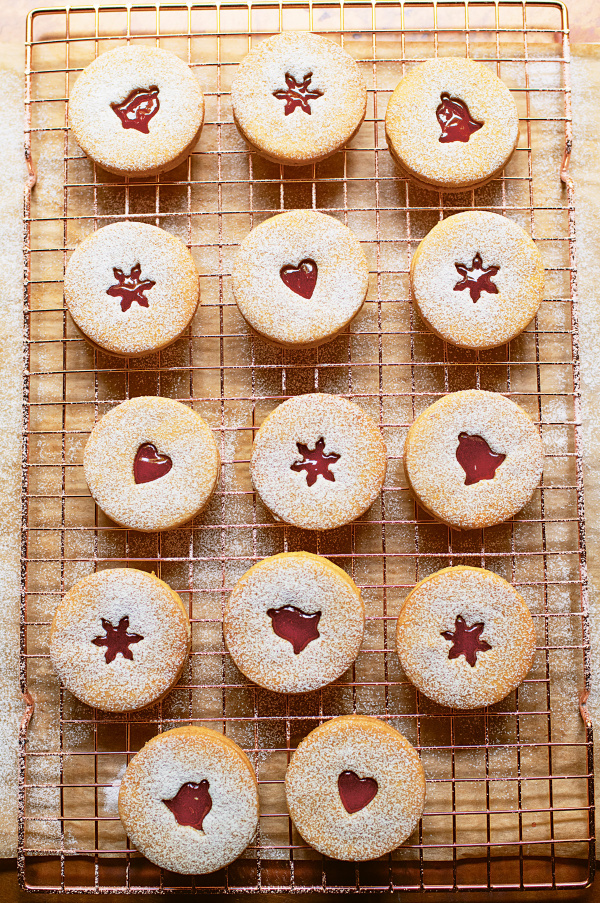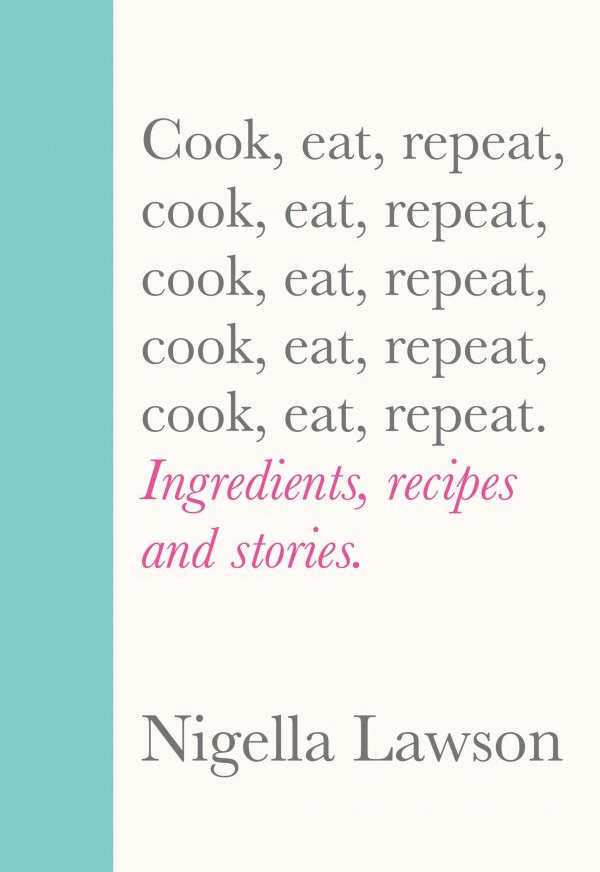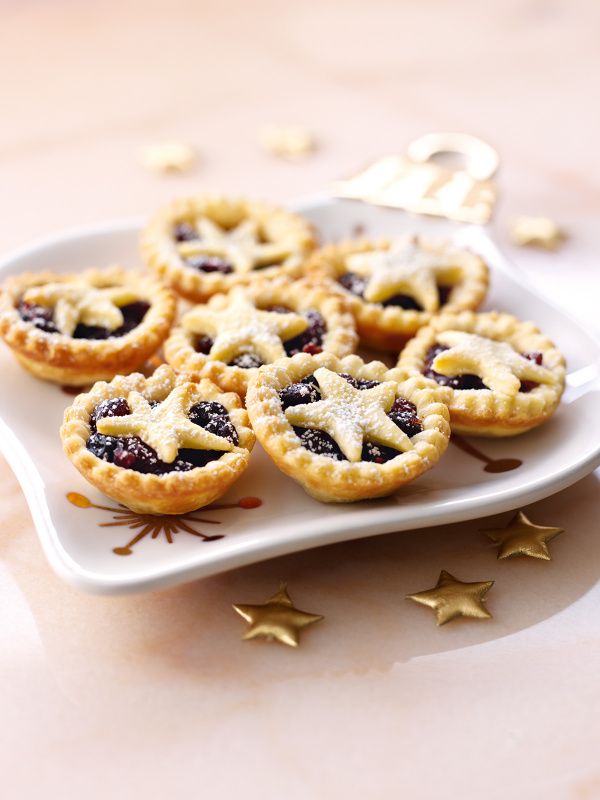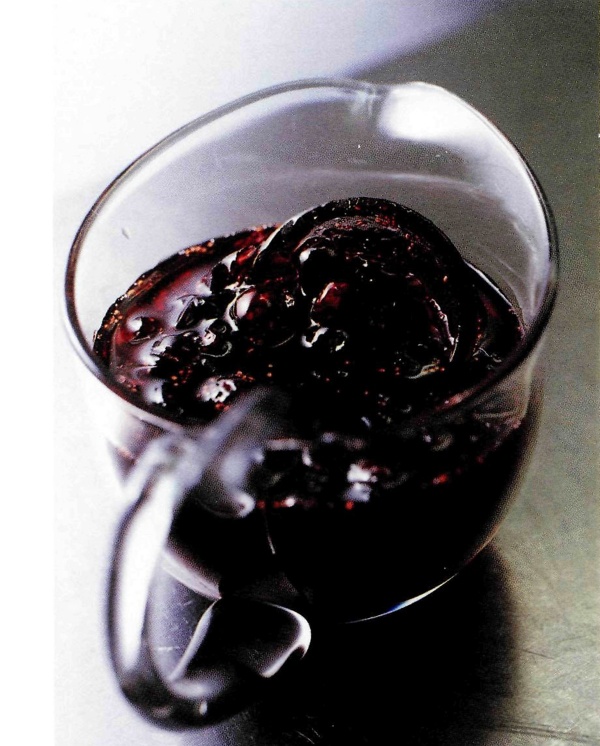Linzer Cookies
by Nigella. Featured in COOK EAT REPEATIntroduction
In its wildest dreams, a jammy dodger could never aspire to the melting tenderness and celestial lightness of the Linzer cookie. The idea is the same: two biscuits, sandwiched together with jam, a hole or small shape cut out of the top one, so that the jam glints beckoningly through. But the Linzer cookie is the extravagant Austrian Christmas version, the dough rich and short with ground toasted hazelnuts.
I buy skinned hazelnuts that have already been toasted, but it's easy enough to find blanched or skinned hazelnuts and not enormously hard work to toast them on a lipped baking sheet in a 180°C/160°C Fan/350°F oven for 10-15 minutes. But you must make sure they're completely cold before you grind them to dust. Of course, you could change tack altogether and replace the hazelnuts with 100g / 1 cup of ready-ground almonds.
You'll need a 6cm / 2¼-inch round cookie cutter (smooth, not crinkle-edged) to make these and, ideally, a set of mini Christmas cutters, though you could always use the sharp end of a piping nozzle. I do feel the investment in the mini cutters is worthwhile, however, as I foresee many batches of these in your future.
In its wildest dreams, a jammy dodger could never aspire to the melting tenderness and celestial lightness of the Linzer cookie. The idea is the same: two biscuits, sandwiched together with jam, a hole or small shape cut out of the top one, so that the jam glints beckoningly through. But the Linzer cookie is the extravagant Austrian Christmas version, the dough rich and short with ground toasted hazelnuts.
I buy skinned hazelnuts that have already been toasted, but it's easy enough to find blanched or skinned hazelnuts and not enormously hard work to toast them on a lipped baking sheet in a 180°C/160°C Fan/350°F oven for 10-15 minutes. But you must make sure they're completely cold before you grind them to dust. Of course, you could change tack altogether and replace the hazelnuts with 100g / 1 cup of ready-ground almonds.
You'll need a 6cm / 2¼-inch round cookie cutter (smooth, not crinkle-edged) to make these and, ideally, a set of mini Christmas cutters, though you could always use the sharp end of a piping nozzle. I do feel the investment in the mini cutters is worthwhile, however, as I foresee many batches of these in your future.

Share or save this
Ingredients
Makes: 28 sandwich cookies, with ruthless re-rolling
- 100 grams whole blanched hazelnuts (toasted if possible - see recipe intro)
- 125 grams caster sugar
- 300 grams plain flour plus more for rolling out
- 200 grams unsalted butter (cold if using a processor, soft if making by hand)
- ¼ teaspoon ground cinnamon
- ⅛ teaspoon fine sea salt
- 1 large egg (at room temperature)
- 1 large egg yolk (at room temperature)
- icing sugar to dust the cookies
- Approx. 4 x 15ml tablespoons redcurrant jelly
- Approx. 4 x 15ml tablespoons seedless raspberry jam
- ¾ cup whole skinned hazelnuts (toasted if possible - see recipe intro)
- ⅔ cup granulated sugar
- 2¼ cups plus 2 tablespoons all-purpose flour plus more for rolling out
- 1 stick plus 5 tablespoons unsalted butter (cold if using a processor, soft if making by hand)
- ¼ teaspoon ground cinnamon
- ⅛ teaspoon fine sea salt
- 1 large egg (at room temperature)
- 1 large egg yolk (at room temperature)
- confectioners' sugar to dust the cookies
- Approx. ¼ cup redcurrant jelly
- Approx. ¼ cup seedless raspberry jam
Method
- For the processor method: tip the toasted hazelnuts and sugar into the bowl of the processor and blitz until you have fine sand, then add the flour. Cut the cold butter into 1cm/½-inch dice and add to the processor, along with the cinnamon, salt, whole egg and egg yolk. Run the processor until the contents start to cohere and form a dough; this won't happen instantly, so be patient.
- If you don't have a processor but have a bullet blender, you can grind the hazelnuts in that. Or if you have neither, simply use ready-ground almonds. And to make the cookies by hand, mix the ground nuts with the flour, cinnamon and salt and set aside for a moment. Cream the butter and sugar together. Whisk together the whole egg and egg yolk in a jug then beat them very gradually into the butter mixture. Add the dry ingredients, a little at a time, and beat in until the mixture forms a soft dough.
- Whether you've mixed the dough by hand or in a processor, divide evenly into 4. Roll each quarter into a ball, then gently squash to form fat patties. Cover tightly in food wrap and put in the fridge for 1 hour. You can, in fact, leave them in the fridge for up to 3 days.
- Once your dough has rested, take two of the discs out of the fridge and let them stand for about 15 minutes, or longer if either your fridge is very cold or the dough's been sitting in it for a long time, heating the oven to 180℃/160℃ Fan/350°F while you wait. Get out a couple of cookie sheets and cut two pieces of baking parchment exactly the same size as the sheets.
- Put one piece of parchment directly on the counter and when the dough feels ready to roll — firm, but not too cold — roll out one of the discs thinly (2-3mm / 1/16-inch thick) on it. If you find your dough is very sticky, you can roll it out between two pieces of parchment.
- Using a 6cm/2¼-inch round cookie cutter, dipped first in flour, cut 6 circles out of the rolled dough. You don't have to leave a huge gap between the cookies, as the dough doesn't really spread much. Lift away the excess dough, leaving your circles on the parchment. Carefully place this parchment on one of your cookie sheets. Form a ball with the excess to add to the remainder of the other 3 discs later.
- Repeat the process with the next disc, only this time you're making the top half of the cookie, so you will need to choose your mini cutters, dip them in flour and then cut out your shapes — a small hole, heart, Christmas tree, snowflake, angel or star — and if the shape you're stamping out doesn't come out with the cutter, use a cocktail stick to help. Add the offcuts to the other scraps of dough, ready for re-rolling. If your kitchen is warm it can really help to put these cookies in the fridge on their parchment-lined cookie sheet for 10 minutes or so, as it will help the cut-out shapes keep a very clean edge.
- Bake the cookies for 9-10 minutes, until they're only just beginning to turn a very light gold at the edges; they will, overall, still be pale. Transfer straightaway to a cooling rack or, if you'd feel safer, gently slide the loaded parchment on to the rack instead.
- Repeat the process with the 2 remaining discs and all the squidged-together offcuts, making sure the cookie sheets have cooled down before you load them up.
- When the cookies are completely cold, they are ready to be sandwiched. Dust the cookies you've cut a shape out of with icing sugar and leave on the wire rack for now. Mix the jelly and jam together until smooth, and spread ½ teaspoon of the mixture over one non-dusted cookie half, leaving a pale frame around the edge. Pick up a sugar-dusted cookie, carefully holding the edges only, and place it on top of the jam-loaded cookie, feeling justifiably proud of yourself and your beautiful Christmassy creation. And carry on with the rest of the cookies, your festive sense of bliss increasing giddily as you go.
- For the processor method: tip the toasted hazelnuts and sugar into the bowl of the processor and blitz until you have fine sand, then add the flour. Cut the cold butter into 1cm/½-inch dice and add to the processor, along with the cinnamon, salt, whole egg and egg yolk. Run the processor until the contents start to cohere and form a dough; this won't happen instantly, so be patient.
- If you don't have a processor but have a bullet blender, you can grind the hazelnuts in that. Or if you have neither, simply use ready-ground almonds. And to make the cookies by hand, mix the ground nuts with the flour, cinnamon and salt and set aside for a moment. Cream the butter and sugar together. Whisk together the whole egg and egg yolk in a jug then beat them very gradually into the butter mixture. Add the dry ingredients, a little at a time, and beat in until the mixture forms a soft dough.
- Whether you've mixed the dough by hand or in a processor, divide evenly into 4. Roll each quarter into a ball, then gently squash to form fat patties. Cover tightly in food wrap and put in the fridge for 1 hour. You can, in fact, leave them in the fridge for up to 3 days.
- Once your dough has rested, take two of the discs out of the fridge and let them stand for about 15 minutes, or longer if either your fridge is very cold or the dough's been sitting in it for a long time, heating the oven to 180℃/160℃ Fan/350°F while you wait. Get out a couple of cookie sheets and cut two pieces of baking parchment exactly the same size as the sheets.
- Put one piece of parchment directly on the counter and when the dough feels ready to roll — firm, but not too cold — roll out one of the discs thinly (2-3mm / 1/16-inch thick) on it. If you find your dough is very sticky, you can roll it out between two pieces of parchment.
- Using a 6cm/2¼-inch round cookie cutter, dipped first in flour, cut 6 circles out of the rolled dough. You don't have to leave a huge gap between the cookies, as the dough doesn't really spread much. Lift away the excess dough, leaving your circles on the parchment. Carefully place this parchment on one of your cookie sheets. Form a ball with the excess to add to the remainder of the other 3 discs later.
- Repeat the process with the next disc, only this time you're making the top half of the cookie, so you will need to choose your mini cutters, dip them in flour and then cut out your shapes — a small hole, heart, Christmas tree, snowflake, angel or star — and if the shape you're stamping out doesn't come out with the cutter, use a cocktail stick to help. Add the offcuts to the other scraps of dough, ready for re-rolling. If your kitchen is warm it can really help to put these cookies in the fridge on their parchment-lined cookie sheet for 10 minutes or so, as it will help the cut-out shapes keep a very clean edge.
- Bake the cookies for 9-10 minutes, until they're only just beginning to turn a very light gold at the edges; they will, overall, still be pale. Transfer straightaway to a cooling rack or, if you'd feel safer, gently slide the loaded parchment on to the rack instead.
- Repeat the process with the 2 remaining discs and all the squidged-together offcuts, making sure the cookie sheets have cooled down before you load them up.
- When the cookies are completely cold, they are ready to be sandwiched. Dust the cookies you've cut a shape out of with confectioners' sugar and leave on the wire rack for now. Mix the jelly and jam together until smooth, and spread ½ teaspoon of the mixture over one non-dusted cookie half, leaving a pale frame around the edge. Pick up a sugar-dusted cookie, carefully holding the edges only, and place it on top of the jam-loaded cookie, feeling justifiably proud of yourself and your beautiful Christmassy creation. And carry on with the rest of the cookies, your festive sense of bliss increasing giddily as you go.
Additional Information
MAKE AHEAD:
Bake cookies up to 3 days ahead. Store, unfilled, in airtight container until needed. Once filled, cookies are best eaten on same day as they will soften over time.
FREEZE:
Freeze uncooked dough discs tightly wrapped and in airtight container for up to 3 months. Defrost overnight in fridge. Freeze baked but unfilled cookies in airtight container for up to 1 month. Defrost at room temperature. Fill cookies as directed in recipe.
MAKE AHEAD:
Bake cookies up to 3 days ahead. Store, unfilled, in airtight container until needed. Once filled, cookies are best eaten on same day as they will soften over time.
FREEZE:
Freeze uncooked dough discs tightly wrapped and in airtight container for up to 3 months. Defrost overnight in fridge. Freeze baked but unfilled cookies in airtight container for up to 1 month. Defrost at room temperature. Fill cookies as directed in recipe.






Tell us what you think
Thank you {% member.data['first-name'] %}.
Explore more recipesYour comment has been submitted.
What 1 Other has said
-
Posted by llrosie on 2nd December 2024
Show more commentsThis is a great recipe. Thank you.